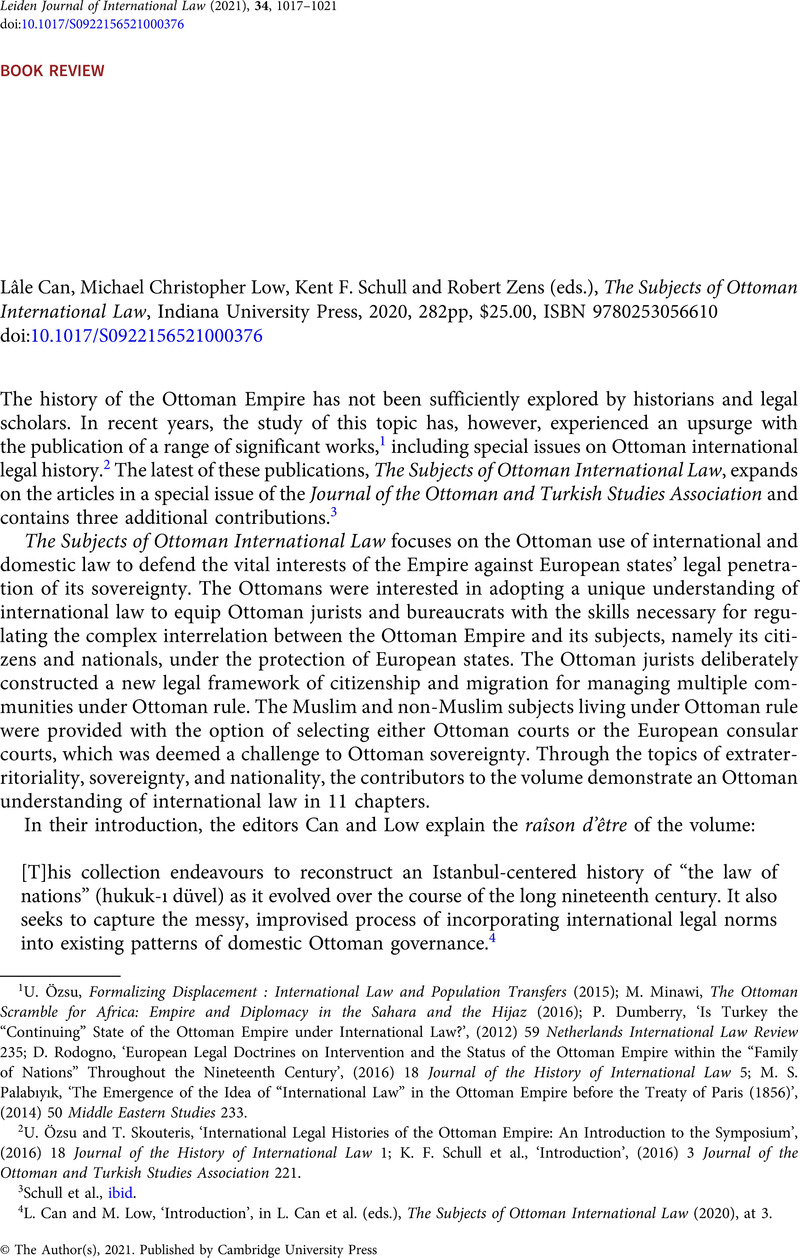No CrossRef data available.
Article contents
Lâle Can, Michael Christopher Low, Kent F. Schull and Robert Zens (eds.), The Subjects of Ottoman International Law, Indiana University Press, 2020, 282pp, $25.00, ISBN 9780253056610
Published online by Cambridge University Press: 18 August 2021
Abstract

- Type
- Book Review
- Information
- Copyright
- © The Author(s), 2021. Published by Cambridge University Press
References
1 U. Özsu, Formalizing Displacement : International Law and Population Transfers (2015); M. Minawi, The Ottoman Scramble for Africa: Empire and Diplomacy in the Sahara and the Hijaz (2016); P. Dumberry, ‘Is Turkey the “Continuing” State of the Ottoman Empire under International Law?’, (2012) 59 Netherlands International Law Review 235; D. Rodogno, ‘European Legal Doctrines on Intervention and the Status of the Ottoman Empire within the “Family of Nations” Throughout the Nineteenth Century’, (2016) 18 Journal of the History of International Law 5; M. S. Palabıyık, ‘The Emergence of the Idea of “International Law” in the Ottoman Empire before the Treaty of Paris (1856)’, (2014) 50 Middle Eastern Studies 233.
2 U. Özsu and T. Skouteris, ‘International Legal Histories of the Ottoman Empire: An Introduction to the Symposium’, (2016) 18 Journal of the History of International Law 1; K. F. Schull et al., ‘Introduction’, (2016) 3 Journal of the Ottoman and Turkish Studies Association 221.
3 Schull et al., ibid.
4 L. Can and M. Low, ‘Introduction’, in L. Can et al. (eds.), The Subjects of Ottoman International Law (2020), at 3.
5 M. Koskenniemi, ‘A History of International Law Histories’, in B. Fassbender and A. Peters (eds.), The Oxford Handbook of the History of International Law (2012), at 970.
6 B. Fassbender and A. Peters, ‘Introduction’, ibid., at 2; A. Anghie, Imperialism, Sovereignty and the Making of International Law (2005).
7 A. Becker Lorca, Mestizo International Law: A Global Intellectual History, 1842-1933 (2016).
8 For discussion on the Ottoman Empire’s status as a semi-peripheral state see U. Özsu, ‘The Ottoman Empire, the Origins of Extraterritoriality, and International Legal Theory’, in A. Orford and F. Hoffman (eds.), The Oxford Handbook of The Theory of International Law (2016), at 124.
9 W. Smiley, ‘Freeing “The Enslaved People of Islam”: The Changing Meaning of Ottoman Subjecthood for Captives in the Russian Empire’, in Can et al., supra note 4, at 35.
10 For a monograph-length treatment of the topic see W. Smiley, From Slaves to Prisoners of War: The Ottoman Empire, Russia, and International Law (2018).
11 A. Genell, ‘The Well-Defended Domains: Eurocentric International Law and the Making of the Ottoman Office of Legal Counsel’, in Can et al., supra note 4, at 52.
12 E. Aviv, ‘Millet System in the Ottoman Empire’ (2016), Oxford bibliographies, available at www.oxfordbibliographies.com/view/document/obo-9780195390155/obo-9780195390155-0231.xml.
13 S. R. Sonyel, ‘The Protégé System in the Ottoman Empire’, (1991) 2 Journal of Islamic Studies 56.
14 U. Özsu, ‘The Ottoman Empire, the Origins of Extraterritoriality, and International Legal Theory’, in Orford and Hoffman, supra note 8, at 127–9.
15 W. Hanley, ‘What Ottoman Nationality Was and Was Not’, in Can et al., supra note 4, at 74.
16 M. Low, ‘Unfurling the Flag of Extraterritoriality: Autonomy, Foreign Muslims, and the Capitulations in the Ottoman Hijaz’, ibid., at 96.
17 L. Can, ‘The Protection Question: Central Asians and Extraterritoriality in the Late Ottoman Empire’, ibid., at 104.
18 F. Ahmed, ‘The British-Ottoman Cold War, c.1880-1914: Imperial Struggles over Muslim Mobility and Citizenship from Suez Canal to the Durand Line’, ibid., at 146.
19 J. Dyer, ‘Pan-Islamic Propagandists or Professional Diplomats? The Ottoman Consular Establishment in the Colonial Indian Ocean’, ibid., at 171.
20 S. Fahrenthold, ‘“Claimed by Turkey as Subjects”: Ottoman Migrants Foreign Passports, and Syrian Nationality in the Americas, 1915-1925’, ibid., at 217.
21 To examine a similar rivalry in Africa see M. Minawi, The Ottoman Scramble for Africa (2016).
22 M. Aksakal, ‘Not “by those old books of international law, but only by war”: Ottoman Intellectuals on the Eve of the Great War’, (2004) 15(3) Diplomacy and Statecraft 507, at 516.
23 J. Stephens, ‘An Uncertain Inheritance: The Imperial Travels of Legal Migrants, from British India to Ottoman Iraq’, in Can et al., supra note 4, at 124; Fahrenthold, supra note 20.
24 M. Craven, ‘Introduction: International Law and its Histories’, in M. Craven, M. Fitzmaurice and M. Vogiatzi (eds.), Time, History and International Law (2007), at 7; R. Lesaffer, ‘Law and History: Law between Past and Present’, in S. Taekema and B. van Klink (eds.), Law and Method. Interdisciplinary Research into Law (2011), 133–52.
25 U. Özsu, ‘Afterword: Ottoman International Law?’, in Can et al., supra note 4, at 239.
26 M. Arvidsson and M. Bak McKenna, ‘The Turn to History in International Law and the Sources Doctrine: Critical Approaches and Methodological Imaginaries’, (2020) 33 Leiden Journal of International Law 37–56.
27 For an illustration on some of the monographs and edited volumes see M. Koskenniemi, The Gentle Civilizer of Nations: The Rise and Fall of International Law 1870–1960 (2001); A. Anghie, Imperialism, Sovereignty, and the Making of International Law (2005); I. de la Rasilla, International Law and History: Modern Interfaces (2021); J. d’Aspremont (ed.), The History and Theory of International Law (2020). See further the Journal of the History of International Law/Revue d’histoire du droit international.


